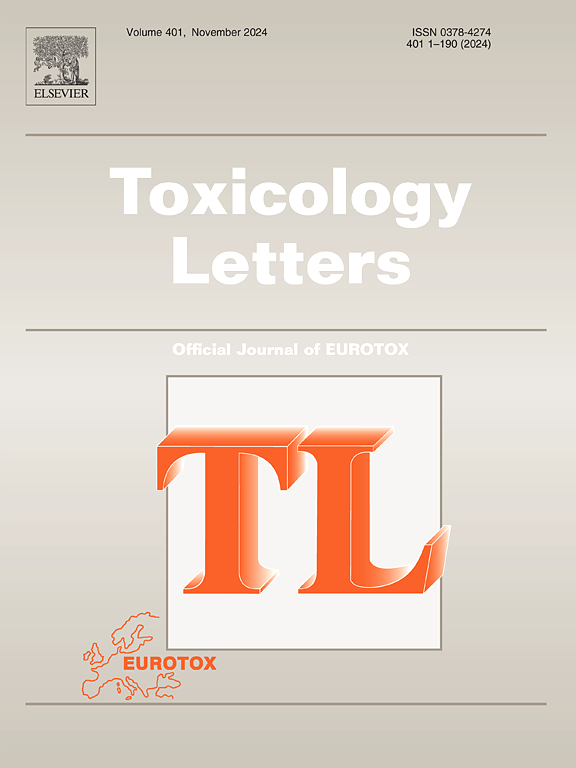孔雀石绿对植物和动物模型的毒性作用:根生长抑制、血液学变化、组织病理学和分子分析的研究
IF 2.9
3区 医学
Q2 TOXICOLOGY
引用次数: 0
摘要
孔雀石绿(MG)是一种暗示肿瘤发展和致癌性的化学物质,被广泛用作非法食品着色剂,对消费者和处理者构成风险。本研究旨在评估MG在植物和动物模型中的毒性作用。采用不同剂量MG(375、750和1500 MG /L)处理大蒜(Allium cepa L.) 24 h,对大蒜根系生长抑制、有丝分裂指数(MI)和染色体畸变进行遗传毒性分析。在动物研究中,40只瑞士白化病小鼠被分为4组:对照组和3个治疗组,分别以375(低)、750(中)和1500(高)MG /kg体重口服MG,持续13周。治疗后对肝脏、肾脏和肠道组织进行血液学、生化、组织病理学和分子分析。MG显著降低了A. cepa根的根长和心肌梗死,并呈剂量依赖性地引起染色体异常。MG治疗显著降低了小鼠的体重,增加了血小板、单核细胞和白细胞计数,同时降低了血红蛋白、红细胞压积和红细胞计数。血清分析显示ALT、ALP、AST、胆红素、肌酐和尿素升高,提示肝毒性和肾毒性。组织病理学检查显示肝脏空泡、充血和炎症浸润,肾小球收缩、肾小管变性和间质水肿,结肠上皮脱落、粘膜下坏死和炎症浸润。RT-qPCR分析显示Bcl-2、Beclin-1和NF-κB mRNA表达升高,Bax mRNA表达降低。这些发现表明,MG是一种强效的基因毒性和致癌物,即使在低剂量下也会威胁人类健康。本文章由计算机程序翻译,如有差异,请以英文原文为准。
Toxic effects of malachite green on plant and animal models: A study on root growth inhibition, hematological changes, histopathology, and molecular analysis
Malachite green (MG), a suggestive chemical for tumor development and carcinogenicity, is widely used as an illicit food coloring agent, posing risks to consumers and handlers. This study aimed to assess the toxic effects of MG in both plant and animal models. Different doses of MG (375, 750, and 1500 mg/L) were applied for 24 h to evaluate root growth inhibition, mitotic index (MI), and chromosomal aberrations in Allium cepa L. roots for genotoxicity analysis. In animal studies, forty Swiss albino mice were divided into four groups: control and three treatment groups, which were orally administered MG at 375 (low), 750 (medium), and 1500 (high) mg/kg body weight for 13 weeks. Hematological, biochemical, histopathological, and molecular analyses were performed on liver, kidney, and intestinal tissues post-treatment. MG significantly reduced root length and MI in A. cepa roots dose-dependently causing chromosomal abnormalities. MG treatment significantly lowered the body weights of mice and increased platelet, monocyte, and white blood cell counts, while reducing hemoglobin, hematocrit, and red blood cell counts. Serum analysis showed elevated ALT, ALP, AST, bilirubin, creatinine, and urea, indicating hepatotoxicity and nephrotoxicity. Histopathological examination revealed vacuolation, congestion, and inflammatory infiltration in the liver, glomerular shrinkage, tubular degeneration, and interstitial edema in the kidney, and epithelial sloughing, submucosal necrosis, and inflammatory infiltration in the colon. RT-qPCR analysis demonstrated increased Bcl-2, Beclin-1, and NF-κB mRNA expression with decreased Bax mRNA. These findings suggest MG is a potent genotoxic and carcinogenic agent even at lower doses threatening human health.
求助全文
通过发布文献求助,成功后即可免费获取论文全文。
去求助
来源期刊

Toxicology letters
医学-毒理学
CiteScore
7.10
自引率
2.90%
发文量
897
审稿时长
33 days
期刊介绍:
An international journal for the rapid publication of novel reports on a range of aspects of toxicology, especially mechanisms of toxicity.
 求助内容:
求助内容: 应助结果提醒方式:
应助结果提醒方式:


